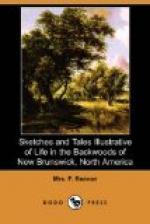TABLE OF CONTENTS.
Introductory Remarks
New Brunswick—by whom settled
Remarks on State of Morals and Religion
American Physiognomy
The Spring Freshets
Cranberries
Stream Driving
Moving a House
Frolics
Sugar Making
Breaking up of the Ice
First appearances of Spring
Burning a Fallow
A Walk through a Settlement
Log Huts
Description of a Native New Brunswicker’s
House
Blowing the Horn
A Deserted Lot
The Bushwacker
The Postman
American Newspapers
Musquitoes
An Emigrant’s House
Unsuccessful Lumberer
The Law of Kindness exemplified in the
Case of a Criminal
Schools
The School Mistress
The Woods
Baptists’ Association
A Visit to the House of a Refugee
The Indian Bride, a Refugee’s Story
Mr. Hanselpecker
Burning of Miramichi
The Lost One—a tale of the
Early Settlers
The Mignionette
Song of the Irish Mourner
A Winter’s Evening Sketch
The School-mistress’s Dream
Library in the Backwoods
The Indian Summer
The Lost Children—a Poem
Sleigh Riding
Aurora Borealis
Getting into the Ice
Conclusion
These sketches of the Backwoods of New Brunswick are intended to illustrate the individual and national characteristics of the settlers, as displayed in the living pictures and legendary tales of the country. They have been written during the short intervals allowed from domestic toils, and may, perhaps, have little claim to the attention of the public, save that of throwing a faint light upon the manners and customs of that little-known, though interesting, appendage of the British empire. A long residence in that colony having given me ample means of knowing and of studying them in all their varying hues of light and shade. There, in the free wide solitude of that fair land whose youthful face “seems wearing still the first fresh fragrance of the world,” the fadeless traces of character, peculiar to the dwellers of the olden climes, are brought into close contrast with the more original feelings of the “sons of the soil,” both white and red, and are there more fully displayed than in the mass of larger communities. Of political, or depth of topographical information, the writer claims no share, and much of deep interest, or moving incident, cannot now be expected in the life of a settler in the woods. The days when the war-whoop of the Indian was yelled above the burning ruins of the white man’s dwelling are gone—their memory exists but in the legend of the winter’s eve, and the struggle is now with the elements which form the climate; the impulse of “going a-head” giving impetus to people’s “getting along”—forcing the woods to bow beneath their sturdy stroke, and fields to shine with ripened grain, where erst the forest shadows fell; or floating down the broad and noble streams the tall and stately pine, taken from the ancient bearded wilderness to bear the might of England’s fame to earth and sea’s remotest bounds.




